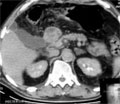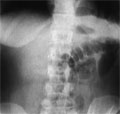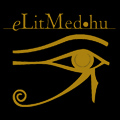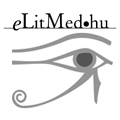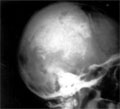The eLitMed.hu medical portal uses computer cookies for convenient operation. Detailed information can be found in the Cookie-policy.
Hungarian Radiology - 2002;76(02)
Content
[Dilemma of screening for lung cancer]
[Lung cancer still represents one of the greatest and unsolved health problem of the world. The lung cancer mortality rate is the highest among all cancer cases in both genders. While the world is focusing on both primary and secondary prevention, the position of mass screening for lung cancer is complex and controversial, yet. This raises many issues that can only solved by a multidisciplinary approach. This summary is intending to help the radiologists to make the right decision in our modern computerised world. Nowadays one of the most important question is if screening of the high-risk group with low-dose spiral CT is efficient and cost-effective.]
[The incidence of Hirschsprung disease with associated congenital anomalies]
[INTRODUCTION - Several publisactions described the association of Hirschsprung disease with other congenital anomalies. Most studies were in relation with the neurological, ophthalmological and ear-nose-throat disorders. The authors did not find any publication in the Hungarian literature presented other anomalies in patients with Hirschsprung disease. PATIENTS AND METHODS - The data of 43 patients treated for Hirschsprung disease at the Department of Paediatrics of Pécs University was analysed. The most frequent associated anomalies e. g. Down syndrome, omphalocele, anorectal malformation, annular pancreas, torticollis, syndactylia, Meckel diverticulum, upper urinary tract disorder and undescendent testis were studied. The patients who had several congenital anomalies were evaluated separately as well as those having congenital inguinal hernia. The authors compared the number of congenital anomalies occurred in patients with Hirschsprung disease with the incidence of these congenital disorders occurred in non-Hirschsprung patients in the literature. RESULTS - Among 43 patients, 6 children had associated congenital anomalies. 3 patients had only one of the following disorders: undescendent testis, urinary tract duplication and Down syndrome. 3 patients suffered from multiplex congenital anomalies: 1. Down syndrome with annular pancreas and torticollis. 2. Omphalocele, anal atresia, vesicoureteric reflux and syndactylia. 3. Anus atresia, Meckel diverticulum and limb (radius) hypoplasia. In addition 3 patients had other anomalies such as unilateral and bilateral inguinal hernia and umbilical hernia. CONCLUSION - On the basis of our results we can state that the incidence of other associated congenital anomalies are higher in patients with Hirschsprung disease. Single organ developmental anomaly is rare, it usually occurs in association with multiorgan disorders. Most likely this is the explanation why patients with Hirschsprung disease have more associated anomalies.]
[Fals diagnosis of a pancreas tumor]
[INTRODUCTION - Stromal tumors of the gastrointestinal tract are rare and the diagnosis is often not straitforward. CASE REPORT - A case of a 75-year-old male patient with a duodenal stromal tumor is presented. The differential diagnosis was difficult, since the mass mimicked a tumor of the pancreatic head. Authors briefly review of the characteristics of gastrointestinal stromal tumors. CONCLUSION - The role of diagnostic imaging in the diagnosis of stromal duodenal tumors is secondary. Correct diagnosis can be established using immunhistological and electromicroscopis studies, only.]
[Atypical diaphragmatic herniation causing bowel obstruction]
[INTRODUCTION - A 21-year-old woman presented with iatrogenic diaphragmatic hernia causing bowel obstruction. CASE REPORT - Plain abdominal X-ray and barium swallow examinations showed a diaphragmatic hernia causing partial gastric obstruction. Surgery confirmed the radiological diagnosis. The hernia was located atypically at the centre of the diaphragm. CONCLUSION - The cause of the hernia was probably related to a pyogenic necrosis due to subphrenic abscess after cholecystectomy performed 2 years earlier, treated by drainage and repeated surgical interventions.]
1.
Clinical Neuroscience
[Headache registry in Szeged: Experiences regarding to migraine patients]2.
Clinical Neuroscience
[The new target population of stroke awareness campaign: Kindergarten students ]3.
Clinical Neuroscience
Is there any difference in mortality rates of atrial fibrillation detected before or after ischemic stroke?4.
Clinical Neuroscience
Factors influencing the level of stigma in Parkinson’s disease in western Turkey5.
Clinical Neuroscience
[The effects of demographic and clinical factors on the severity of poststroke aphasia]1.
2.
3.
4.
5.






